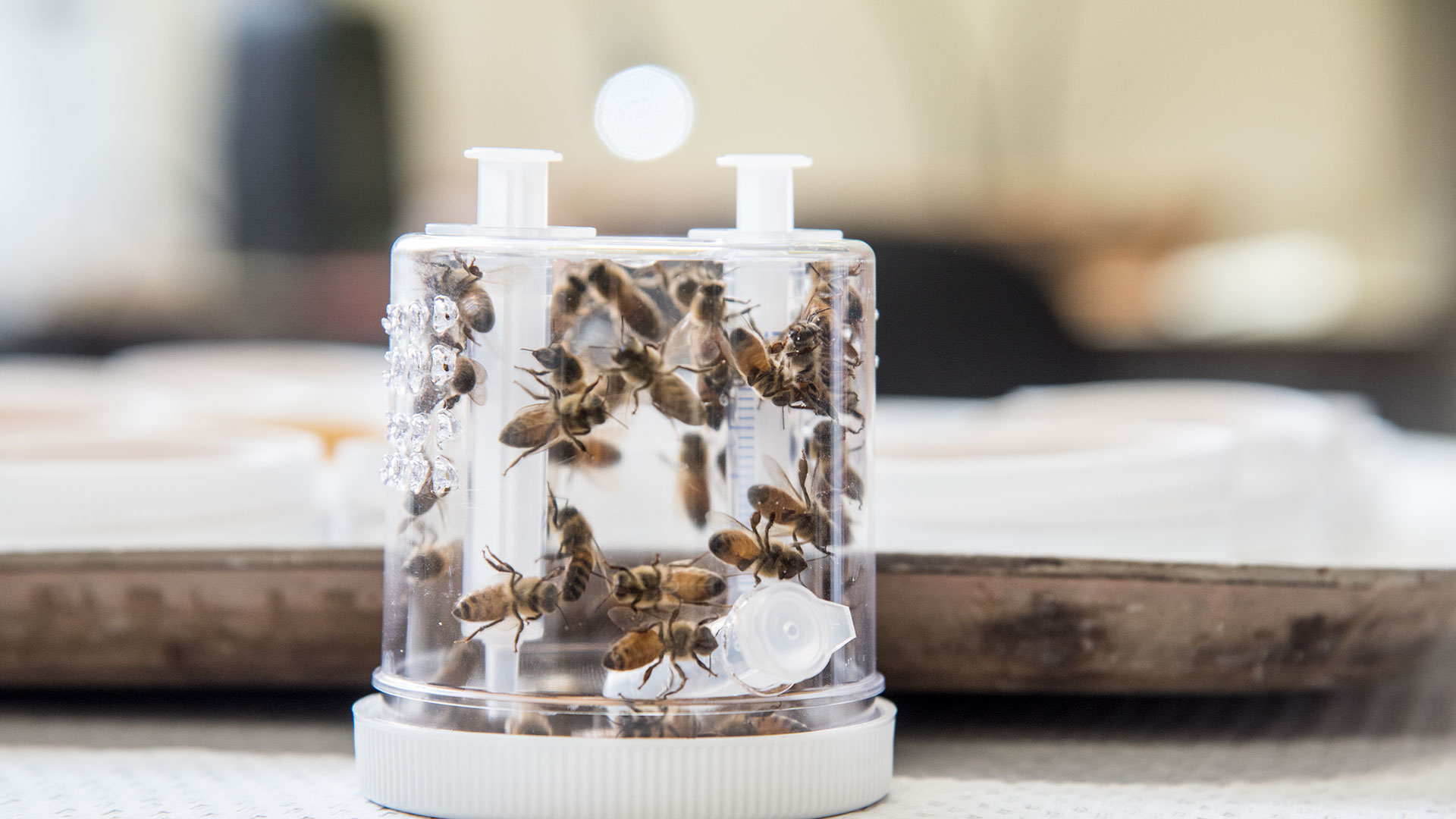The honey bee is a keystone species, and without it, Jamie Ellis says, one out of every four or five bites you eat would disappear.
“Twenty percent of my diet is not citrus, it’s not beef or dairy. It’s not poultry, wheat or corn,” says Ellis, the Gahan Endowed Professor of Entomology and leader of the University of Florida’s honey bee research program.
“But 20 to 25 percent of what I eat comes from the efforts of honey bees.”
Ellis says there are 20,000 species of bees on the planet. About 4,000 or so live in North America. There are 315 to 320 species of bees in Florida. Eight species of honey bees are confined to Asia.
Just one species of honey bee has a foothold in the U.S.
That makes the honey bee the workhorse of pollinating many food crops — watermelon, blueberries, strawberries, apples, almonds (especially almonds). And that makes Ellis and a team of honey bee research and extension scientists keenly focused on keeping the honey bee healthy.
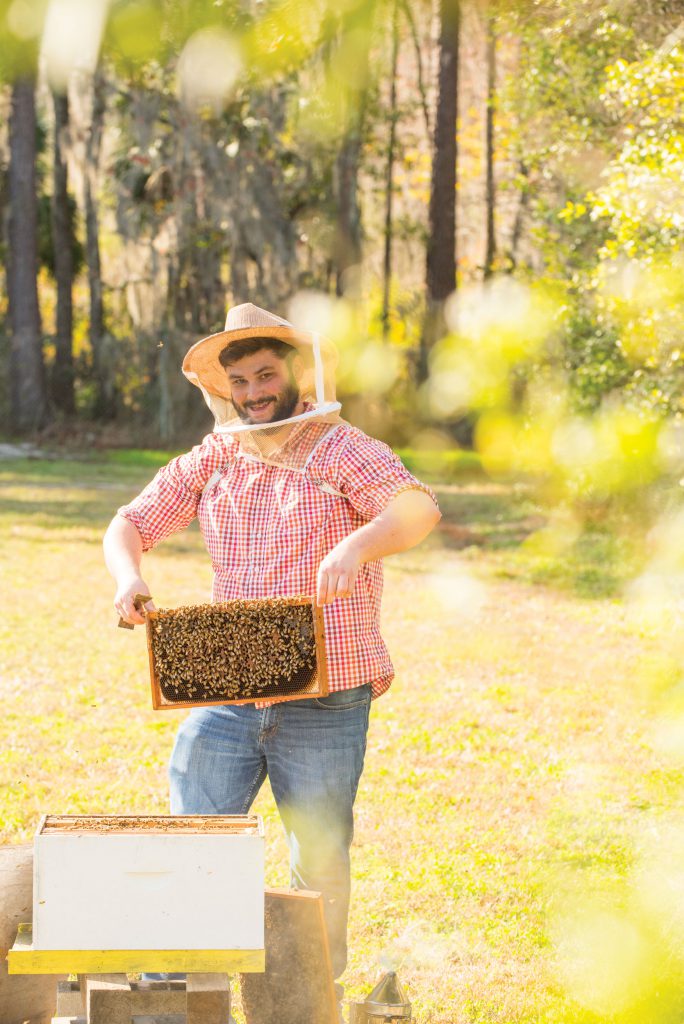
Native bees — bumblebees, sweat bees, carpenter bees and others — pollinate, too, but much of the work of pollinating crops, up to $20 billion worth nationally, is up to the honey bee, the only easily managed pollinator.
The UF Honey Bee Research and Extension Laboratory has about 40 active research projects and is poised to ramp up research on several fronts after moving into a new home in August. The $4.5 million facility grew out of a groundswell of support from state beekeepers, from coins dropped in collection jars to a check for $500,000 from a hobbyist beekeeper. The facility — a bee campus of sorts — has a museum, a pavilion for outdoor teaching and meetings, an indoor classroom, labs, honey bee-themed artwork and an observation room with special lighting for bee-watching.
And of course, bees, buzzing in and out of the trademark white boxes that house their hives.
Inside the Box
Ellis has been a beekeeper since he was a boy and a bee scientist for decades, and even he says some of what goes on inside the hives is still a mystery.
“Most of what we know about honey bees comes from our knowledge of these bees in white boxes, the managed hives,” Ellis says. “And people continue to discover things in the white boxes that we just didn’t know before.”
One new discovery, by colleagues in Maryland with support from UF, is that Varroa mites are feeding on bee fat bodies. For 30 years or more, the bee world thought they were feeding on hemolymph, or bee blood.
“The number one pest of honey bees has been feeding on something entirely different than that on which we believed it to be feeding,” says Ellis, who was a co-author on the paper in the Proceedings of the National Academy of Sciences. “This will change treatment strategies, and it explains a lot of Varroa’s impact on bee colonies.”

Not long after Ellis arrived to take over the UF bee research and extension program in 2006, calls went out to save the bees. Colony collapse disorder had bees abandoning their hives in droves, with beekeepers losing up to 40 percent of their colonies.
In the decade since, there’s been a boom in beekeeping, with new hives offsetting losses of old hives, staving off the “beepocalypse,” Ellis says. And a more nuanced view of the vulnerability of bees has emerged as well. Ellis uses the term colony losses these days to describe a host of ailments that threaten the viability of a hive, including mites, such as Varroa, bee nutrition, queen health and pesticides.
Mites, especially Varroa, are a robust research arena for UF, with one doctoral student working on Varroa full time.
“Varroa is the cancer of the honey bee world,” Ellis says. “It is the honey bee world’s public enemy No. 1.”
Despite the attention, making progress on Varroa has been difficult. Honey bees are arthropods, but so are Varroa mites. Nearly all controls for Varroa are arthropodicides.
“Using an arthropodicide to fight an arthropod inside an arthropod colony … it’s not like killing a tick or a flea on a mammal,” Ellis says. “Killing an arthropod on an arthropod is remarkably tricky because it’s difficult to find new compounds that are active against Varroa but not the bee. And even if the compound isn’t lethal to the bee, it could have delayed, sub-lethal effects.”
Another complication is that Varroa must be collected from hives in order to study it in the lab. UF’s honey bee lab is working on in vitro or lab methods of rearing Varroa as a means of speeding up testing for treatments.
“If we nail down that rearing method, we could look at novel ways of controlling them, for example, keeping them from reproducing,” Ellis says. “You can only do this work if you can physically watch Varroa in the lab through its rearing cycle.”
Well-Fed Bees
Honey bee nutrition is an expanding area of investigation. There are two things bees need when they forage. When they go to a flower, they are either collecting nectar — a sugar water that flowers produce — or they are collecting pollen.
Nectar becomes honey, and serves as fuel for the bees.
“Honey is what moves the bee. When they consume honey, they’re getting carbohydrates that allow them to move their legs, beat their wings,” Ellis says. “It powers all the activity of a hive.”
From the pollen, they make bee bread, which contains all the protein and other nutrients they need.
It’s hard to imagine bees, flitting from flower to flower, not getting enough fuel or food, but Ellis says that happens. Honey bees are generalist foragers, meaning they collect nectar and pollen from a variety of flowers, without focusing on one species.
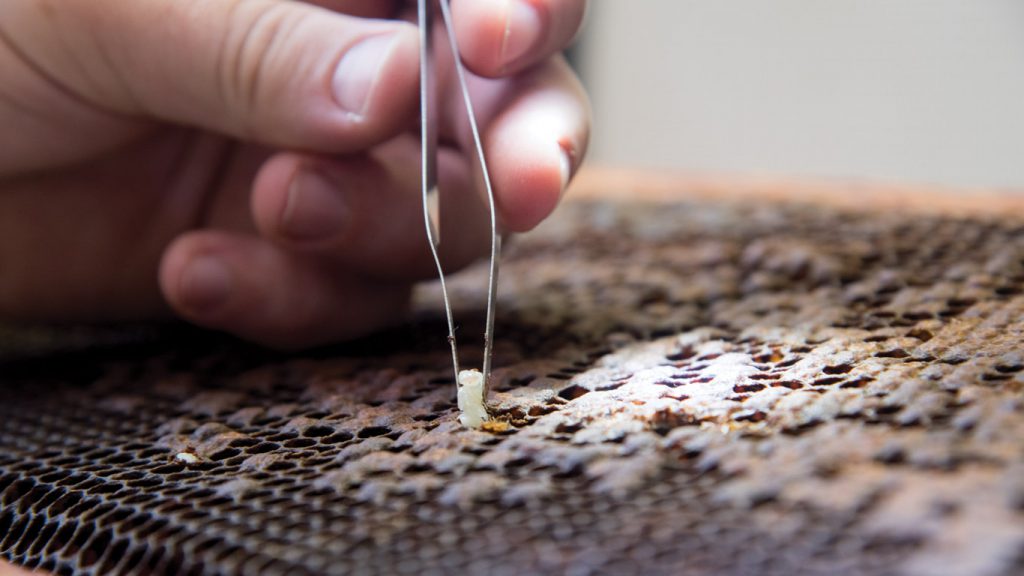
But commercial honey bees don’t have a pollen smorgasbord. They may be served a feast of almond flowers, but it’s only almond flowers, and that unbalanced diet creates a nutritional deficit.
“Sometimes the bees simply run out of honey,” Ellis says. “The way you solve that is you feed them sugar water or corn syrup.”
Sugar water solves the honey issue but the pollen issue is more complicated, because pollen is needed for the production of new bees, and new bees are necessary to keep pollination businesses booming. Bees will not rear offspring if they can’t collect pollen of a sufficient quality and bring it back to the hive. So, seasons matter.
“We are in a pollen dearth right now,” Ellis said in December.
To get a colony to produce offspring when it otherwise would not, beekeepers feed pollen supplements. The question, Ellis says, is do they work? Some pollen patties, he says, amount to “expensive poop.”
“Just because it goes into the mouth doesn’t mean it is going into the system,” Ellis says. “It might be going straight through the bee.”
Figuring out the value of pollen supplements is important, considering that 20 to 25 percent of managed bee colonies — about 650,000 — travel through Florida each year. Some overwinter in Florida as they prepare to head elsewhere to pollinate. For example, in January, the number one crop that needs pollination is almonds, mainly in California, so Florida bees are shipped west.
The pollen supplements are particularly important in a pollen dearth, when bees are being asked to work overtime during their slow season.
“Most honey bee colonies shut down in the winter months, essentially hibernating as it were,” Ellis says. “We’re trying to get bee colonies to be strong at a time of year they’re not ordinarily strong.”
Better nourished bees might also mean healthier bees, with lower disease incidence. Ellis says the group is just beginning to look at how nutrition affects tolerance to diseases and pests. So far in studies of pollen patties, the group has not noted an increase in the number of bees in fed colonies, which would be expected if the patties work.
“Our bees are not only important for Florida crops,” Ellis says, “they’re important for the nation’s crops.
“I can’t think of another ag commodity that is as important for the world as are honey bees.”
Pesticide Protection
Pesticides also play a role in bee health, and to investigate bee exposure to chemicals the lab perfected a system to rear honey bees indoors to better observe the impacts of toxins. With its rearing system, the lab can take larva and rear them to adulthood in 21 days.
Farmers need pesticides to protect their crops, but beekeepers need to know their bees are not hurt by those pesticides.
Testing occurs on three levels, from lab conditions to field conditions, testing mortality after exposure to pesticides. For effective tests, both the exposed bees and the controls need to live to adulthood, but in earlier tests, not enough of the controls were surviving.
With a test the lab developed, more than 90 percent of the controls live to adulthood, making for better comparisons between exposed and unexposed bees. The new method underwent an international test and 13 of 16 laboratories had 80 percent or greater survivorship of the control bees.
The test, expected to become a model, has made it possible to do a wide range of toxicology tests in the past two or three years, including investigating sub-lethal impacts of pesticides on developing honey bees.
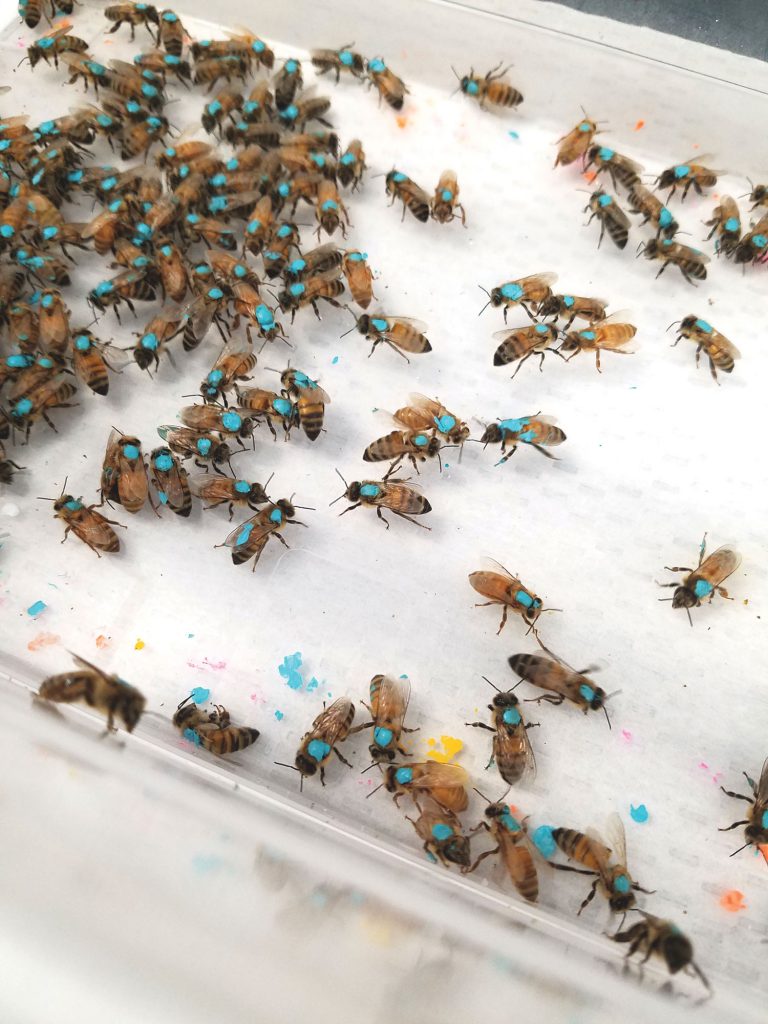
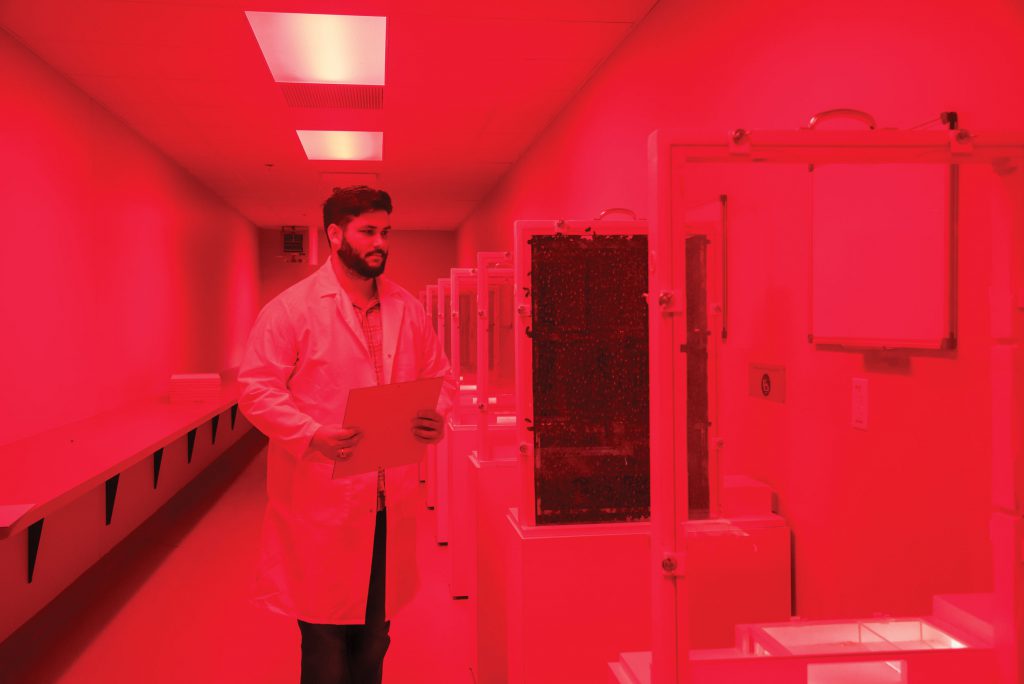
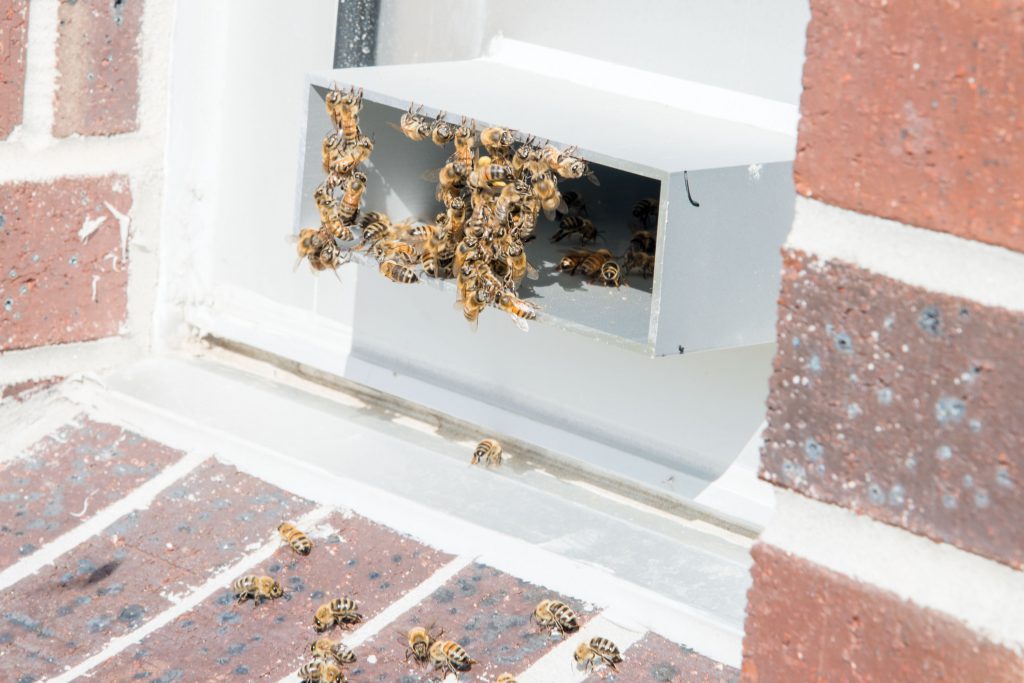
“Bees can be treated with levels of pesticides we know they will survive, and then we can watch how their exposure affects parameters beyond just survivorship,” Ellis says. “It was a major, major breakthrough for us. We’re making the tests that exist more biologically relevant.”
Honey bees are the most studied and highly managed bees, but there is a need to examine other bees, too, Ellis says.
Over the years, the lab’s program on pollination ecology, which encompasses all bees, grew to the point that the UF Entomology and Nematology Department hired Assistant Professor Rachel Mallinger in 2017 just to focus on pollination ecology. The 315 or so other bee species in Florida, after all, are contributing to crop pollination as well.
Bumblebees, for example, contribute to blueberry pollination, but just how much pollen they move is unknown. Sweat bees contribute to watermelon pollination. Unlike honey bees, many wild bees are solitary and nest alone rather than as a colony so little is known about where they nest and how they choose their nests.
Little is known, too, about honey bee behavior in the wild.
“We still have questions about what’s going on in the white boxes,” Ellis says. “If it’s a mystery what goes on in the white boxes, then it’s an enigma what goes on in a feral or wild colony.”
Natural history questions have long gone unanswered with honey bees, Ellis says. When left alone, what do they do? How do they sort themselves out and at what densities? What are natural disease and pest pressures for unmanaged bees? Are some bee colony issues artifacts of the way bees are managed? Ellis thinks perhaps so.
Bee Boom
The rising popularity of beekeeping heartens Ellis but doesn’t surprise him. For an animal that stings, bees are nevertheless charismatic, and they fit the urban farming moment society is in just now. More and more, people are adding bees to their chickens and blueberries and raised beds of veggies.
The public took to heart the pollination message in campaigns to save the bees and keep fruits, nuts and vegetables in supermarkets. In 2006, there were 1,100 beekeepers registered in Florida. Today, there are almost 5,000. While hobbyists outnumber commercial beekeepers, commercial operations manage 92 percent of honey bees in Florida.
Beekeeping classes, too, are increasingly popular, so much so that the Department of Entomology and Nematology just hired Lecturer Cameron Jack to focus on it full time. Each fall and spring semester, the course draws about 120 students and about 60 in the summer. Ellis says Jack is developing a certificate program, with multiple courses related to beekeeping.

“We’ll have something no other university has,” Ellis says. “You can go to almost any other land grant and get a course on bees. We’ve already got two, but we’re shooting for six, seven, eight.”
With the new lab and new positions, Ellis says he’d like to see the bee campus become a bee center, a “one-stop shop for research, extension and instruction.”
“We’re getting there,” Ellis says. “We now have the facility to support that.”
Ellis says the public-private collaboration that funded the center astounded him. A group of beekeepers approached him five or six years ago and wanted to help him buy lab equipment.
“I said, ‘Look guys, you can buy it but I have nowhere to put it,’” Ellis says. As a joke, he suggested, “Go get a lab.”
“Everybody and their brother in the Florida bee world was raising money.”
The new 16,000-square-foot facility, Ellis says, will amplify the lab’s research, instruction and extension efforts, and that was the goal of the bee community, says David Mendes, a Fort Myers beekeeper who wrote a check for $200,000 to kick off the fundraising.
“Nothing like this exists anywhere else in the country,” Mendes says. “Florida is a particularly good area to raise bees. The climate helps, of course, but a lot of it is because of Jamie himself. In Florida, beekeeping and research go hand in hand.
Bee Keeper
Ellis grew up in rural east-central Georgia and barely remembers when bees weren’t a part of his life. In a hazy memory, he recalls being about 6 when someone came to his school to give a demonstration about bees. The speaker gave out brochures, and the brochure ended up in his toy box. At 8, he tried to convince his parents to get him bees, with no luck. But he was hooked and kept reading about bees.
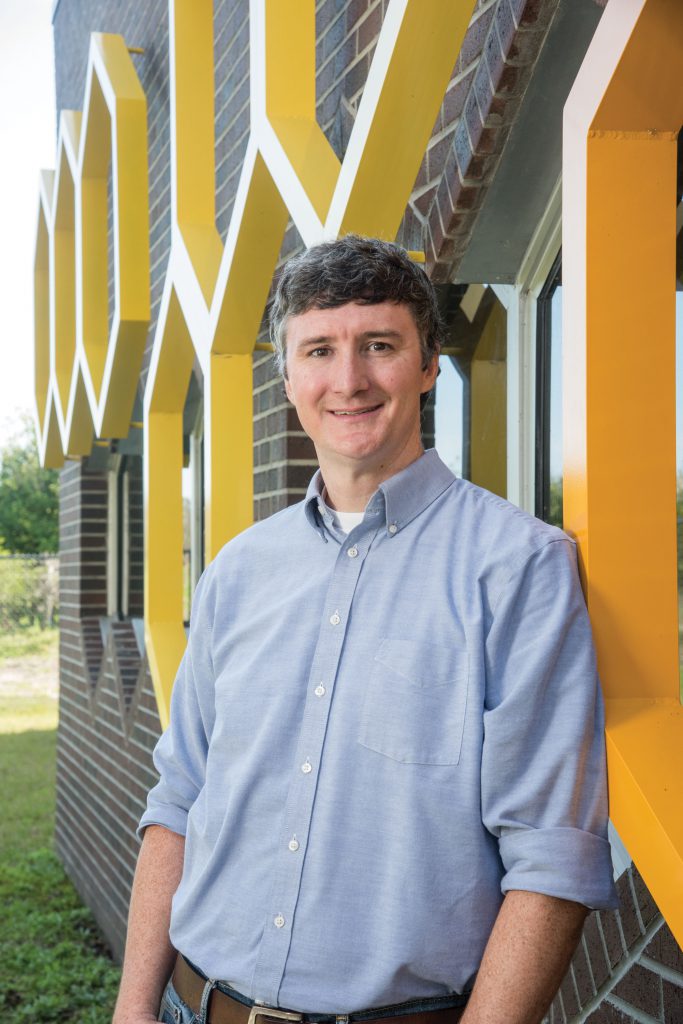
In sixth grade, at age 12, he ended up talking with his teacher about bees, bemoaning his beelessness. The teacher’s uncle, it turned out, was a beekeeper.
“She said, ‘If I get you an empty beehive, will you promise to fill it?’” Ellis recalls.
A few weeks later, “she showed up at our house with a beehive.”
Ellis’ parents, backed into a corner, got him bees from a local beekeeper. When the beekeeping mentor died a year later, Ellis became the owner of 15 more hives at the age of 13 and managed his bees at his grandfather’s dairy farm. Bees were part of every science fair and 4-H project, and when he went to college at the University of Georgia, he was close enough to home to keep his bees. At Georgia, he worked in a bee lab much like the one he joined at UF in 2006, but fully intended to go to medical school. He figured that’s what kids who liked science did.
His course corrected when his mentor took him aside.
“He said, ‘Look Jamie, it’s clear you like bees and you like research. You know that bee science is what you’re supposed to do,’” Ellis says.
Today, Ellis keeps bees in his backyard. He says he is one of the few bee scientists who also is a beekeeper. The rewards are professional, but personal, too.
“I’ve always been happy around bees.”
Source:
- Jamie Ellis, Gahan Endowed Professor of Entomology and Nematology
Hear the Story
The audio version of this story is available on our YouTube.
Related website:
Related story:
Explore Magazine originally featured this article in its Spring 2019 issue.

